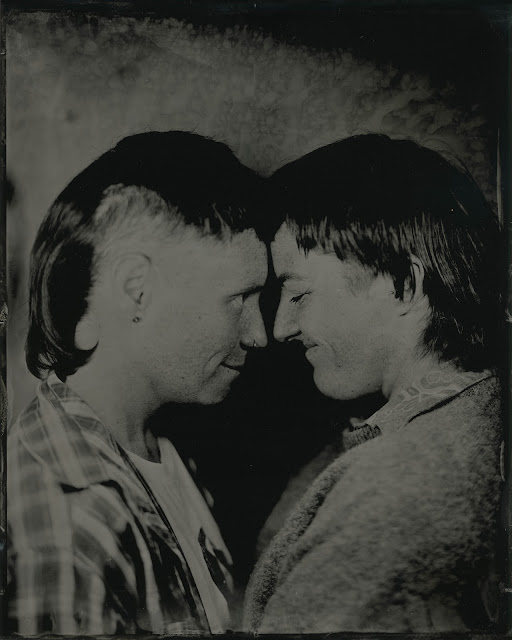Photography Review | Brian Rope
Prue Hazelgrove | I am
that I am – a deconstruction
Emily Portmann | Aftercare
Xi Li, Meng-Yu Yan and
Joseph Blair | Transcending bodies
Photo
Access | 11 August to 10 September 2022
Across the three gallery spaces, these exhibitions come together to de-construct traditional ideas of identity and interrogate ideologies of self that exist within society. Each exhibition employs distinct methods in exploring societal definitions of self, suffering, and gender nonconformity.
Bringing tintype and collage processes into conversation, Prue Hazelgrove’s I am that I am – a deconstruction examines histories of queer visibility and erasure. The artist says she “is attempting to transform harm into healing through representation and reclamation.”
Hazelgrove achieves her
goals most successfully with her excellent well-constructed paper, photo and
text collages. Close reading of each piece of text clipped from a Christian
self-help book clearly reveals the story of each particular artwork. The act of
having cut up the texts for use in the collages can be seen as having removed
any sense of authority they may have had in the source book. Their use also
brings vividly to mind the dreadful selective use of scriptural texts by those
who have sought, and still do seek, to make people conform to their views of
what is right or wrong.

Prue Hazelgrove, Too much Skin- I am that I am, 2022, paper, photo and text collage
 |
| Prue Hazelgrove, According to Gods design- I am that I am, 2022, paper, photo and text collage |
A number of high-quality
tintypes complement the collages, revealing with raw honesty the people
portrayed. Using the tintype medium fits with its long-standing use for
documentation and adds to the artist’s intention of reclaiming her right to
“exist as I am”.
 |
Prue Hazelgrove, Just a couple of good buds – I am that I am, 2022, Tintype |
The catalogue for
Hazelgrove’s exhibition also features a piece of fine writing by Emma
Batchelor, a queer writer, award-winning author and dancer from Canberra. This
piece, Ultra Visible, should be read intently.
In Aftercare, the artist, Emily Portmann, presents a video of her performance as she encases her head in a large pink roll of bubble wrap. Using a sheet of the same pink bubble wrap as the backdrop in the gallery for the video screen is a nice touch. The video is accompanied by a series of self-portraits taken during the performance, each exploring the emotional and psychological ideology behind self-care and wellbeing. In each of them her head has become a large pink cylinder. Hands explore this mysterious object, searching for something unknown to us. The catalogue suggests we are viewing an emerging parody of “a society in which fetishised notions of self-comfort, protection and healing coincide with the commercialisation of wellbeing.”
 |
Emily Portmann, Aftercare, Action 7, 2021 , archival pigment print |
Then there is a group exhibition
by Xi Li, Meng-Yu Yan and Joseph Blair. Transcending Bodies employs
video, 3D animation, AI and printed photo-media to challenge normative ideas of
identity and envision new forms of living in the virtual realm.
This exhibition explores how sense-of-self and social dynamics are shaped in virtual environments and brings into focus the possibilities and limits of existing online, untethered from our physical bodies. The catalogue speaks of the existence of hybrids of machine and organism being reality, drawing attention to the fact that many of us now have technological items implanted in our bodies functioning to keep us in better health – or even alive.
There also is a catalogue reference to the way so many of us use social media video games, phone Apps and other technological things on a daily basis, thus moving our physical selves into the virtual realm.
In his series Postcards from Hyrule, Meng-Yu Yan has taken the role of photographer within a virtual space. We see screenshots of this virtual world in a Game played during COVID-19 lockdown. They present as illusory or ghost-like landscapes, with an apparition here and a luminous nebula there. They are printed on a metallic gloss paper as postcards, suggesting they are souvenirs acquired from another planet. Each artwork is a worthy inclusion in the show.
 |
Meng-Yu Yan, Postcards from Hyrule 5, 2021, inkjet print on Ilford Metallic gloss |
Joseph Blair contributes
two diptych works from a series The Tongue of Missing Lovers. Each comprises
a photographic portrait accompanied by words about the subject and expressing a
feeling about that person. They have an emotional impact if we allow it.
,%202022,%20inkjet%20prints,%20diptych.jpg)
Joseph Blair, A Much Larger Tip (From series The Tongue of Missing Lovers), 2022,
inkjet prints, diptych
The third artist in the group is the interdisciplinary Xi Li. Here we see 8.5 minutes of video, Brain Island: Hyperreal City. It is important to take a seat because the strong probability is that you will want to view it more than once. This is as fine a video artwork as I have seen. It draws you in, uncertain as to what you might come next. So much is happening all through this work that during each viewing you will observe something new.
 |
Xi Li, Brain Island Hyperreal City, 2019, video still |
Li has woven so many
aspects of her own identity into this remarkable piece. She has inserted
herself into the work utilising green screen compositing – a process of layering
two images or video streams into one another. We see her various alter-egos and
contradictory cultures, reflecting her lived experience under both Chinese and
Western political systems.
These three exhibitions and their catalogues are each well worth visiting and spending time with.
This review was first published on page 18 of The Canberra Times of 5.9.22 and online here. It is also on the author's blog here.